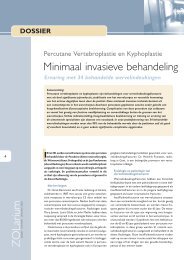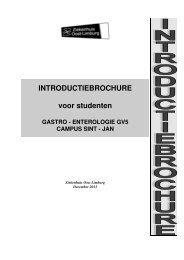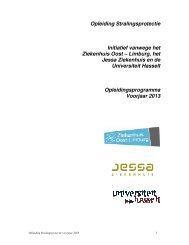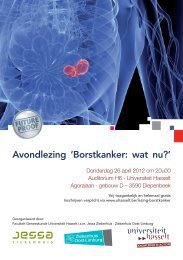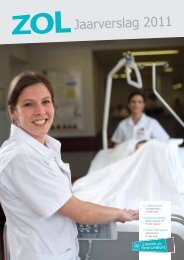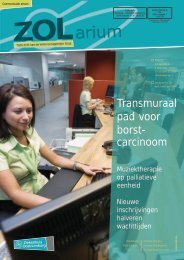Gerizol over ouderen op spoed Gerizol over ouderen op spoed
Gerizol over ouderen op spoed Gerizol over ouderen op spoed
Gerizol over ouderen op spoed Gerizol over ouderen op spoed
Create successful ePaper yourself
Turn your PDF publications into a flip-book with our unique Google optimized e-Paper software.
patients has stabilized since 2006 at<br />
approximately 2100 patients per year. The<br />
majority of foreign nationals seeking treatment<br />
in Belgium were French women for<br />
sperm donation. The next highest group<br />
was patients entering the country to<br />
obtain ICSI with ejaculated sperm.<br />
Conclusions: There are clear indications<br />
that numerous movements are motivated<br />
by the wish to evade legal restrictions in<br />
one’s home country, either because the<br />
technology is prohibited or because the<br />
patients have characteristics, which exclude<br />
them from treatment in their own<br />
countries.<br />
6. Diagnostic accuracy of transvaginal<br />
ultrasound examination for assigning a<br />
specific diagnosis to adnexal masses<br />
Ultrasound Obstet Gynecol 2009; 34: 462–<br />
470<br />
Published online 17 August 2009 in Wiley<br />
InterScience (www.interscience.wiley.<br />
com). DOI: 10.1002/uog.6444<br />
A. Sokalska*, D. Timmerman†, A. C.<br />
Testa‡, C. Van Holsbeke†, A. A Lissoni§, F.<br />
P. G. Leone, D. Jurkovic**And L.<br />
Valentin‡<br />
*Division of Infertility and Reproductive<br />
Endocrinology, Department of Gynecology,<br />
Obstetrics and Gynecological Oncology,<br />
Karol. Marcinkowski University of Medical<br />
Sciences, Poznan, Poland, †Department of<br />
Obstetrics and Gynecology, University<br />
Hospitals KU. Leuven, Belgium, ‡Istituto di<br />
Clinica Ostetrica e Ginecologica, Università<br />
Cattolica del Sacro Cuore, Rome, §Clinica<br />
Ostetrica e Ginecologica, Ospedale S.<br />
Gerardo,Università di Milano Bicocca,<br />
Monza and Clinical Sciences Institute L.<br />
Sacco, University of Milan, Milan, Italy,<br />
**Department of Obstetrics and<br />
Gynaecology, King’s College Hospital,<br />
London, UK and ‡Department of<br />
Obstetrics and Gynecology, Malmö<br />
University Hospital, Lund University,<br />
Malmö, Sweden.<br />
Abstract<br />
Objectives: To determine the sensitivity<br />
and specificity of subjective evaluation of<br />
gray-scale and D<strong>op</strong>pler ultrasound findings<br />
(here called pattern recognition) when<br />
used by experienced ultrasound examiners<br />
with regard to making a specific diagnosis<br />
of adnexal masses.<br />
Methods: Within the framework of a<br />
Eur<strong>op</strong>ean multicenter study, the<br />
International Ovarian Tumor Analysis<br />
study, comprising nine ultrasound centers,<br />
women with at least one adnexal mass<br />
were examined with gray-scale and color<br />
D<strong>op</strong>pler ultrasonography by experienced<br />
ultrasound examiners. A standardized examination<br />
technique, and standardized<br />
terms and definitions were used. Using<br />
pattern recognition the examiners classified<br />
each mass as benign or malignant<br />
and suggested a specific diagnosis (e.g.<br />
dermoid cyst or endometrioma). The reference<br />
standard was the histology of the<br />
surgically removed adnexal tumors.<br />
Results: A total of 1066 women were<br />
included, of whom 800 had a benign mass<br />
and 266 a malignant mass. A specific<br />
diagnosis based on ultrasound findings<br />
was suggested in 899 (84%) tumors. The<br />
specificity was high for all diagnoses<br />
(range, 94–100%). The sensitivity was<br />
highest for benign teratoma/dermoid cysts<br />
(86%, 100/116), hydrosalpinges (86%,<br />
18/21), peritoneal pseudocysts (80%, 4/5)<br />
and endometriomas (77%, 153/199), and<br />
lowest for functional cysts (17%, 4/24),<br />
paraovarian/parasalpingeal cysts (14%,<br />
3/21), benign rare tumors (11%, 1/9),<br />
adenofibromas (8%, 3/39), simple cysts<br />
(6%, 1/18) and struma ovarii (0%, 0/5).<br />
The positive and negative likelihood ratios<br />
of pattern recognition with regard to dermoid<br />
cysts, hydrosalpinges and endometriomas<br />
were 68.2 and 0.14, 38.9 and 0.15,<br />
and 33.3 and 0.24, respectively. Dermoid<br />
cysts, hydrosalpinges, functional cysts,<br />
paraovarian cysts, peritoneal pseudocysts,<br />
fibromas/fibrothecomas and simple cysts<br />
were never misdiagnosed as malignancies<br />
by the ultrasound examiner, whereas more<br />
than 10% of inflammatory processes, adenofibromas<br />
and rare benign tumors including<br />
struma ovarii were misdiagnosed as<br />
malignancies.<br />
Conclusions: Using subjective evaluation<br />
of gray-scale and D<strong>op</strong>pler ultrasound<br />
findings it is possible to make an almost<br />
conclusive diagnosis of a dermoid cyst,<br />
endometrioma and hydrosalpinx. Many<br />
other adnexal pathologies can be recognized<br />
but not confidently confirmed or<br />
excluded.<br />
7. Use of ultrasound pattern recognition<br />
by expert <strong>op</strong>erators to identify borderline<br />
ovarian tumors: a study of diagnostic<br />
performance and interobserver<br />
agreement<br />
Ultrasound Obstet Gynecol (2009)<br />
Published online in Wiley InterScience<br />
(www.interscience.wiley.com). DOI:<br />
10.1002/uog.7334<br />
J. Yazbek*, L. Ameye†, D. Timmerman‡,<br />
A. C. Testa§, L. Valentin, T. K. Holland*,<br />
C. Van Holsbeke‡ And D. Jurkovic**<br />
*Early Pregnancy and Gynaecology<br />
Assessment Unit, King’s College Hospital<br />
and **Department of Obstetrics and<br />
Gynaecology, University College Hospital,<br />
London, UK, †Department of Electrical<br />
Engineering, Katholieke Universiteit<br />
Leuven and ‡Department of Obstetrics<br />
and Gynecology, University Hospitals KU,<br />
Leuven, Belgium, §Gynaecologic Oncology<br />
Unit, Catholic University of Sacred Heart,<br />
Rome, Italy and Department of<br />
Obstetrics and Gynaecology, Malmö<br />
University Hospital, Malmö, Sweden<br />
Abstract<br />
Objective To assess the accuracy and<br />
reproducibility of ultrasound ‘pattern<br />
recognition’ for the diagnosis of borderline<br />
ovarian tumors by asking experienced<br />
ultrasound <strong>op</strong>erators to evaluate representative<br />
images of different types of adnexal<br />
tumor.<br />
Methods Digitally stored static twodimensional<br />
B-mode images of representative<br />
cases of benign, borderline and invasive<br />
malignant ovarian tumors were independently<br />
assessed by three expert sonologists<br />
who had not performed the original<br />
real-time ultrasound examination. The outcome<br />
measures included diagnostic<br />
accuracy and interobserver agreement in<br />
the diagnosis of benign, borderline or<br />
invasive malignant ovarian tumors.<br />
Results One hundred and sixty-six cases<br />
were included in the final data analysis. A<br />
correct classification was made by all<br />
three experts in 83% of the primary invasive<br />
cancers, 76% of the benign masses<br />
and in 44% of the borderline malignant<br />
tumors (P < 0.01). The experts showed a<br />
tendency to misclassify borderline tumors<br />
as benign rather than primary invasive<br />
(ratio of 8 : 1 for Expert A, 4 : 1 for B and<br />
6 : 1 for C). The interobserver agreement<br />
between any two experts was very good<br />
ZOLarium I Ziekenhuis Oost-Limburg<br />
37



